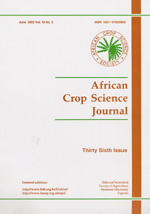
|
African Crop Science Journal
African Crop Science Society
ISSN: 1021-9730
EISSN: 1021-9730
Vol. 6, No. 4, 1998, pp. 407-415
|
 Bioline Code: cs98043
Bioline Code: cs98043
Full paper language: English
Document type: Short Communication
Document available free of charge
|
|
|
African Crop Science Journal, Vol. 6, No. 4, 1998, pp. 407-415
| fr |
Ssekabembe, C.K.
Résumé
Le napier (Pennisetum purpurem Schum.) est
extrêmementt valable en Afrique de l'Est, mais la haute production en
biomasse est souvent limitée par un faible
établissement. Une expérience a été
conduite à l'Institut de recherche Agricole de
l'Université
Makerere, à Kabanyolo (MUARIK) en vue de déterniner
l'effet de la
méthode de plantation sur la pousse et la survie des trois
variétés de bouture de Napier. Les méthodes de
plantation en position érigée et à plat ont
été comparées. Durant la période de 10
à 52 jours après la plantation, l'ILCA 16791 était
supérieur en pourcentage de la pousse, au
développement des feuilles pleinement ouverts et de 10
à 15 cm de longueur, et par conséquent, avait le plus
bas pourcentage des plants ayant échoué à la
pousse. La méthode de plantation en position
érigée a donné un pourcentage beaucoup plus
décevant sur la pousse de bouture de Napier, mais
généralement, la méthode de plantation n'a pas eu d'effet considérable sur la
taille, la croissance et la survie du plant. La survie a
varié suivant les saisons.
Mots Clés
l'enfouissement, position érigée, variété de Napier, méthode de plantation, pousse, survie
|
| |
| en |
Effect Of Planting Method On Establishment Of Napier Grass Varieties
Ssekabembe, C.K.
Abstract
Napier grass (Pennisetum purpureum Schum.) is
extremely valuable in eastern Africa, but high biomass production
is often limited by poor establishment. An experiment was carried
out at Makerere University Agricultural Research Institute,
Kabanyolo (MUARIK) to determine the effect of planting method on
sprouting and survival of Napier cuttings for three varieties.
Erect and prostrate planting methods were compared. During the
period 10 to 52 days after planting, ILCA 16791 was superior in
percentage sprouting, development of fully opened leaves and 10 to
15 cm long leaves, and consequently had the lowest percentage of
plants failing to sprout. The erect planting method resulted in a
slightly higher percentage of sprouted Napier cuttings, but,
generally, planting method did not have a significant effect on
sprouting, growth and plant survival. Survival varied significantly
between seasons.
Keywords
Burial, erect, Napier grass variety, planting method, sprouting, survival
|
| |
© Copyright 1998 - African Crop Science Society
|
|
